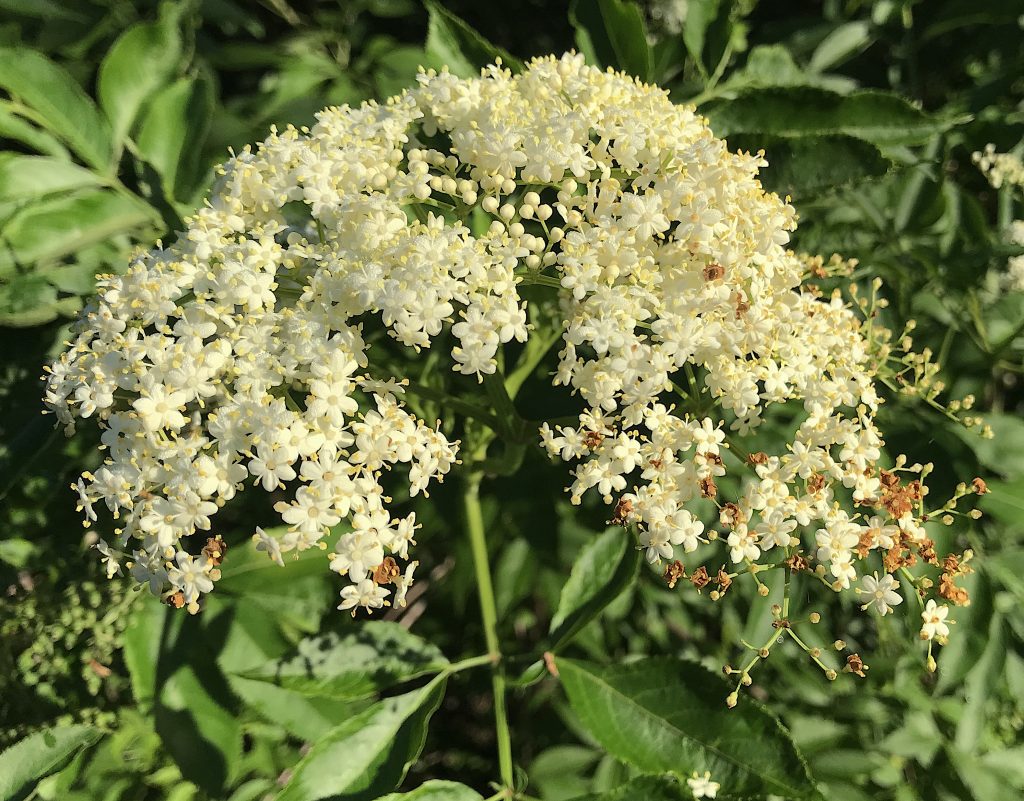
Elderberries bloom all year locally but favor the spring. Photo by Green Deane
This week’s debatable question is “can you eat elderberries raw?” I also call it “arguable” because no matter whether I say yes or no someone will email me and tell me I’m wrong. My answer is yes, and no which means I will irritate both sides. There are a few variables but it’s fairly easy to sort out.
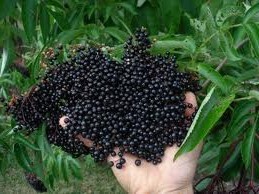
A handful of delicious? Photo by Green Deane
Elderberries contain two kinds of toxins, an alkaloid and cyanide-producing glucosides. The alkaloid is present in unripe berries. It is not a problem in ripe berries but ripe berries still have the cyanide-producing glucosides. If we are referring to dark purple elderberries, such as Sambucus canadensis or Sambucus Mexicana, the answer is yes, you can eat a few if you are an adult, very few if you are a child. If we are talking about red elderberries (Sambucus pubens and Sambucus racemosa ) the answer is definitely no regardless of your size. You can only eat the cooked pulp of red elderberries and then no seeds. Red elderberries were a staple of some Indians but only after much processing. In shirt-sleeve language the cyanide-producing glucosides is usually sugar and cyanide bonded together which break apart on digestion producing a small amount of hydrocyanic acid aka prussic acid… cyanide. Your body can tolerate some cyanide. Thus eating raw ripe berries becomes a function of how many of these molecules there are, how much you ate of them, how large are you and how much water there is in your digestive system which probably relates to how quickly you digest them which means how quickly is that cyanide release. A few raw ripe berries usually does not bother an adult any more than eating half-a-dozen apple seed. More than a few ripe purple elderberries can make a child ill usually with digestive upset and vomiting. Same with an adult. Raw elderberries are well-known to cause nausea. Cooking (or drying) ripe purple elderberries eliminates the problem completely. I’ve eaten a tablespoon of raw ripe purple elderberries at a time and not been bothered. But, I know of many adults who have eaten a handful and gotten sick, not at death-door’s-ill but sick nonetheless. The amount of toxicity is considered mild which means little when you’re feeling lousy.
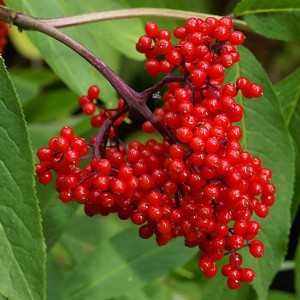
Red Elderberries are mostly toxic.
Ripe Red Elderberries are different than purple ones. They have much more potential cyanide material in their seeds and cooking does not get rid of that problem completely. That is why Native Americans ate only cooked red elderberries with the seeds removed, a labor-intensive process. Said another way red elderberry seeds cannot be eaten raw or cooked but red elderberry pulp can be eaten after cooking, and even that is debatable. So the answer is yes you can eat some ripe, raw purple elderberries but no you should not eat a lot, if only to be safe. Personally I think ripe dark purple elderberries taste far better dried or cooked than raw. Drying or cooking drives off a musty quality they tend to have and improves the flavor. Let me also give you an example using elderberries why on the Green Deane Forum, my Facebook pages and here Wikipedia is not allowed to be referenced (because it is so inaccurate about wild edibles.) Supposedly referencing an article by the Center for Disease Control Wikipedia reports. “In 1984, a group of twenty-five people were sickened, apparently by elderberry juice pressed from fresh, uncooked Sambucus mexicana berries. All recovered quickly, however, including one individual who was hospitalized after drinking five glasses. Such reported incidents are rare.” What does the report really say? The incident was in 1983 not 1984. Twenty-five people were at the event, not 25 taken ill. Eleven people were sickened, eight were flown to the hospital. One stayed overnight. The “juice” was not made from just elderberries but elderberries, elderberry stems, and elderberry leaves (as well as apple juice, sugar and water.) The juice also sat for two days before being consumed. The report does not say the elderberries were “unripe.” This is exactly why you cannot trust Wikipedia for foraging information.
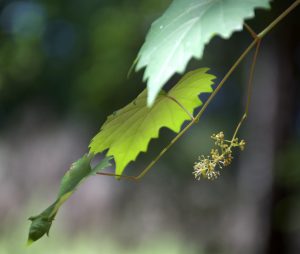
Our local muscadine blossoming. Photo by Green Deane
Not all of botany is settled. There are at least six species of grapes locally, Vitis aestivalis, V. cinera, V. palmata, V. rotundifolia, V. shuttleworthii and V. vulpina. Their status has been the topic of debate but as of late all six are currently considered native. One, V. rotundifolia, might be moved out of the grape genus. It’s closely related to Peppervine and Virginia Creeper and has 38 genes instead of the usual 40 for grapes. It could be cleaved into two species — munsoniana and popenoei — in a new genus of Muscadinia. This weekend we got a chance to see two species blossoming. We saw V. aestivalis, The Summer Grape. It has forked tendrils and will annually produce a bunch of sweet grapes about half the size of those sold in grocery stores. The other was V. rotundifolia, simply called muscadine. It has a single tendril and fruits irregularly with clusters of grapes. They are often very acidic. The leaves and blossoms of the two species are different. The Summer Grape often has fuzzy leaves and a long spike of blossoms. The Muscadine leaves are hairless and the blossom is a cluster. While one usually finds grapes ripening around early September they can be found from late July to early October. You can read about grapes here.
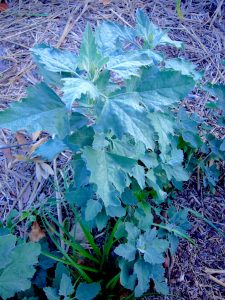
Which of a dozen Pig Weeds is it? Photo by Green Deane
The common names of plants can cause problems. I recently saw some on-line posts in which one person insisted the plant was “Shiny Blueberry.” No doubt that is how they learned it and it stuck. The problem is common names are … well… common. There’s more than a dozen “pig weeds” in the United States, certainly half a dozen “hog plums” and many “Indian Potatoes” and “Indian” teas, berries, and roots. Worse does “Indian” refer to American Indians or India? “Indian Gooseberry” comes to mind. In some regards the name is pointless. What’s really important is that you know the plant, inside and out, you have no doubt what it is. At that point the name is trivial. A century or more ago your mother would have said “that plant is edible” and “that plant is not edible.” No names needed. More to the point we got along nicely without botanists and nutritionists for a very long time. That said I will admit to preferring scientific names because — in theory — a plant has only one botanical name. Better said plants are supposed to have only one official botanical name. As DNA analysis is employed more many plants and mushrooms are changing names and relatives. Historically they were first grouped by characteristics one could see with the unaided eye. Later the microscope changed things. And in the modern era DNA sequencing is upsetting a lot of pseudo-apple carts. As for the “Shiny Blueberry” I was leaning towards Vaccinium darrowii more than V. myrsinites. Why? The blossoms and stems on the former are tinged redder. Both, however, are tasty, shiny crown berries.
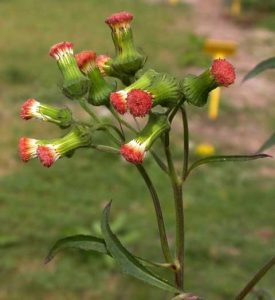
Redflower Ragweed is edible, don’t confuse it with toxic Florida Tassel Flower.
This leads me to my second naming issue. I saw a plant in February that was oddly familiar but new to me. Briefly said it looked like two different species forced into one. I couldn’t remember the common name which I vaguely recalled was misleading. It was also an edible species thus expanding the menu. We tried finding it on my website before class — WordPress is so difficult to upgrade and expand, more on that later — but couldn’t even though I was sure I wrote about it. In short the plant is Redflower Ragweed but it isn’t really a “ragweed” as most North Americans know the word. The common ragweed that launches a million sneezes annually is Ambrosia artemisiifolia. Redflower Ragweed is not an Ambrosia. It is Crassocephalum crepidioides (kras-oh-SEF-uh-lum krep-pid-dee-OY-deez.) Crassocephalum is from the Dead Latin “Crassus” meaning “thick” and “kephale” which is Greek for head. Crepidioides is more mangle Greek. “-oides” in Dead Latin is mispronounced borrowed Greek and means “resembles.” Crepidioides means “resembles Crepis.” Crepis is from an old Greek word for a frilly funeral veil. It works its way into English via French as “crepe” paper. So “thick head resembles crepe paper” is one way to interpret the plant’s name.” And… even though it is called the Redflower Ragweed its leaves more resemble Fireweed/Burnweed, Erechtites hieraciifolius (which is an even more complicated, naughty story.) Redflower Rageweed’s blossoms, however, more resemble the toxic Florida Tassel Flower.
Cornucopia II says of Crassocephalum crepidioides on page 37: “Ebolo, Okinawan Spinach, Young leaves and shoots are used as a potherb, fried, or mixed in Khao yam. The leaves are fleshy, tinged with purple and have a somewhat mucilaginous quality and nutty flavor. Has become quite popular on the island of Okinawa and in Hawaii In Thailand, the roots are eaten with chili sauce or cooked in fish curry. Tropical Africa. Cultivated.”
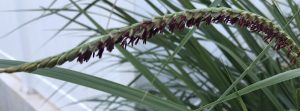
Eastern Gamagrass or Fakahatchi grass starting to blossom. Photo by Green Deane
Grass and ice cream are usually not considered at the same thought unless it is Eastern Gamagrass. Why? Because livestock like the clumping Tripsacinae so much cattlemen call in Ice Cream Grass. While it can be used like wheat it’s a distant relative of corn. Eastern Gamagrass, also called Fakahatchee Grass, is sod-forming and can reach up to eight-feet tall. Though it is pollinating and seeding now the grass can seed from now to September. The frilly male flowers occupy the top three-fourths of the seed spike and the stringy female flowers the bottom fourth. In this species the girls are brown, hair-like structures. Besides fodder Eastern Gamagrass is also a common ornamental found in parks and residential areas. A bunch can live to be 50-years old or more. Fakahatchee, by the way, means either Forked River or Muddy River. Opinions vary. To read more about Eastern Gamagrass go here.
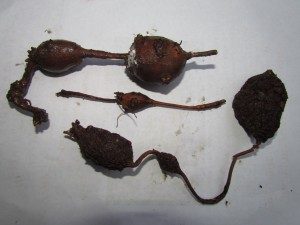
Groundnuts are 26% protein. Photo by Green Deane
Locally May is a transition month. Many of our winter foragables are ending their prime season — sow thistles are a good example — and others are just starting such as Groundnuts. Both of these are found throughout most of North America thus can be in season someplace nearly all year. Here their seasons are about half-a-year off from what one would find in northern climates such as Canada. With classes last week in different parts of the state there was a lot of transitioning to be seen. The aforementioned Groundnuts will soon be blossoming which makes them a bit easier for novices to find. While they have leaflets of 3, 5, and 7 leaves — occasionally 9 — they are otherwise nondescript until they bloom. The deep magenta blossoms get about an inch across and have the classic “wings & keels” one would expect of a plant in the pea family. As pleasing as they are on the eye those blossoms are not pleasant on the nose. It’s an aroma only certain bugs can love. The flowers eventually turn into pea pods and the peas are edible cooked. However, most people don’t eat the seeds: They want the plant’s tasty and nutritious root. The seeds or the roots can be used for propagation and although the Groundnut competes in damp spots it will adapt to your home garden. To read more about the Groundnut, go here.
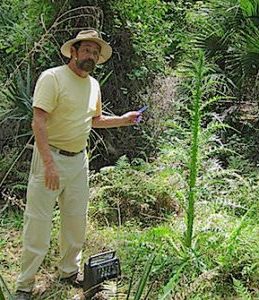
Foraging classes are held rain, shine, hot or cold. Photo by Nermina Krenata
Foraging classes have resumed: Find your own food rather than be dependent on others. While the state has opened some counties are still restricting access to park. By next month those restrictions will hopefully be lessened. This Saturday I have another class close to home, Blanchard Park in east Orlando, and Sunday a long-delayed class in Port Charlotte, always a nice day trip and park.
Saturday, May 9th, Blanchard Park, 10501 Jay Blanchard Trail, Orlando, FL 32817. 9 a.m. to noon, meet at the tennis courts next to YMCA building.
Sunday, May 10th, Bayshore Live Oak Park, Bayshore Drive. Port Charlotte. 9 a.m to noon, meet at the park across from Ganyard Street.
Saturday, May 16th, Boulware Springs Park, 3420 SE 15th St., Gainesville, FL 32641. Meet at the picnic tables next to the pump house. 9 a.m. to noon. (This class date was originally at Spruce Creek in Port Orange but that had to be changed to Gainesville.)
Sunday, May 17th, Red Bug Slough Preserve, 5200 Beneva Road, Sarasota, FL, 34233. 9 a.m. to noon.
For more information, to sign up for a class, or to pre-pay go here.

Green Deane videos are now available on a USB.
Changing foraging videos: My nine-DVD set of 135 videos has been selling for seven years. They are the same videos I have on You Tube. Some people like to have a separate copy. The DVD format, however, is becoming outdated. Those 135 videos plus 15 more are now available on a 16-gig USB drive. While the videos can be run from the DVDs the videos on the USB have to be copied to your computer to play. The are MP4 files. The150-video USB is $99 and the 135-video DVD set is now $99. The DVDs will be sold until they run out then will be exclusively replaced by the USB. This is a change I’ve been trying to make for several years (with thanks to Mike Smith.) So if you have been wanting the 135-video DVD set order it now as the price is reduced and the supply limited. Or you can order the USB. My headache is getting my WordPress Order page changed to reflect these changes. We’ve been working on it for over a week. However, if you want to order now either the USB or the DVD set make a $99 donation using the link at the bottom of this page or here. That order form provides me with your address, the amount — $99 — tells me it is not a donation, and in the note say if you want the DVD set or the USB.
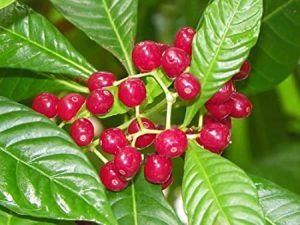
Wild Coffee has no caffein.
When is Wild Coffee not wild coffee? When it is the Coralberry. Both plants look similar from a distance. But as the saying goes no two plants look alike if you get close enough. Wild Coffee, Psychotria nervosa, is extremely over-rated in foraging publications. Anyone who writes you can roast the seeds like coffee and drink it like coffee has never tried it… or coffee I think. Thus the seeds are out. That leaves the seed pulp which is mild but edible. Opinion on just what that flavor is varies greatly. It’s a trail-side nibble when you are on the coast. See that emphasis. Unless intentionally planted Wild Coffee is usually found on the coast (which includes a few miles inland.) It is usually not found in the middle of the state. That is where you find the Coralberry.
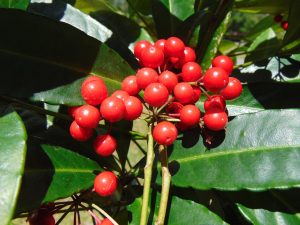
Coralberry is best avoided.
The Coralberry, Ardisia crenata, is an extremely invasive species. It greatly reminds one of the Wild Coffee but there are significant difference including that — currently — the Coralberry is found way inland, in the center part of the state. It also has less prominent leaf veins and blunt teeth around the leaf edge, which is what “crenate” means, a scalloped edge. The Wild Coffee leaf does not have any teeth. Is the pulp of the Coralberry edible? I will say no. The plant has been implicated in cattle poisoning, but they tend to eat leaves, steams and seeds. And there are some shrubs in Florida in the same genus — Ardisia — which have barely edible berries. I will report I ate the pulp off one Ardisia crenata berry. It tasted like green peas and had no immediate or long-lasting effects that I know of. But I don’t recommend doing that. I did not eat the seed.

Green Deane Forum
Want to identify a plant? Perhaps you’re looking for a foraging reference? You might have a UFO, an Unidentified Flowering Object, you want identified. On the Green Deane Forum we — including Green Deane and others from around the world — chat about foraging all year. And it’s not just about warm-weather plants or just North American flora. Many nations share common weeds so there’s a lot to talk. There’s also more than weeds. The reference section has information for foraging around the world. There are also articles on food preservation, and forgotten skills from making bows to fermenting food.
This is weekly newsletter 404, If you want to subscribe to this free newsletter you can find the sign-up form in the menu at the top of the page.
To donate to the Green Deane Newsletter click here.


Hello Dean I was wondering if you are having the same problem that I am, so many people in the last few months learning wild edibles and so many people just guessing, and saying this is that and that is this. wow
what a virus will do to make people stupid, sorry but I have been teaching wild edibles for over 40 years and have been so disrespected over the past few months from people telling me my business so to say. I am waiting for people like us to be shut down because some one is stupid and kills them selves for eating some thing poison. ugh just had to get this out. belong on a few identification sites and people are guessing seems every one wants to know how to eat wild foods these days , any ways hope all is well with you just had to say some thing to some one who has been teaching as long as I have. you site is great . thanks for listening
Donna
People really don’t listen, or comprehend what they read.